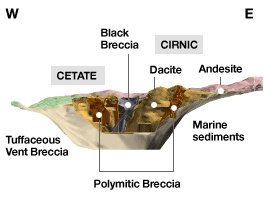Numerous epithermal gold-silver and porphyry copper ore deposits are located in the Golden Quadrilateral area and have been mined since ancient times.
Geological Background
The Rosia Montana deposit is hosted in a maar-diatreme complex intruding Cretaceous age fine grained sediments predominantly comprised of black shales, with subordinate sandstones and conglomerates. The main dacite bodies are the Neogene gold-silver bearing intrusions known as the "Cetate Dacite" and "Carnic Dacite".
Many phreato-magmatic and smaller phreatic breccias which display varying degrees of mineralization have been identified and mapped within the maar-diatreme complex and within the dacite bodies. The phreato-magmatic breccias contain clasts of Cretaceous black shale, sandstone and conglomerate, and crystalline basement clasts such as gneisses and schists in addition to dacite clasts.
One of the largest, the "black breccia" or "glamm" forms a sub-vertical breccia pipe at the very heart of this complex, being situated between the two dacite intrusions does not contain significant mineralization. Another the "Corna" breccia situated to the south of Cetate and Cirnicel has been emplaced post-mineralization and contains primary magnetite and altered dacite clasts but no significant mineralization.
Between Tarina and Jig a series of polymict diatreme breccia bodies have been identified which have intercepted the vent breccia. These breccias are the product of deep phreato-magmatic eruptions along structures, which also explains their cylinder or elongated shapes. In general, these breccia are mineralized. In the Igre zone, dacite and polymict breccias are found within host Creatceous sedimentary units and are interpreted as branches of the diatreme breccia emplaced along smaller faults.
Extrusive andesites are found at the northern and eastern side of the project area and they formed a thin to medium thickness blanket overlying the maar complex. Within this succession, the lower levels are represented by pyroclastic flows and volcanic ashes while to the north and east, the lava flows are seen covering the pyroclastics. These volcanics occurred after mineralization at Rosia Montana.
The Rosia Montana deposits are epithermal, low to intermediate sulphidation systems with relatively simple metallurgy. The mineralization does not contain deleterious antimony, mercury, arsenic or tellurium. Gold occurs as electrum (gold-silver), associated with sulphides (predominantly pyrite) and in the native form. Mineralization is associated with quartz-adularia alteration and later carbonate-clay-sulphides and occurs as disseminations throughout the host rocks.
The bulk of the known reserves are localized within the two adjacent dacitic bodies, Cetate (in the west) and Cirnic (in the east). The surrounding breccia units host the Orlea, Cirnicel and Igre deposits and much of the breccia hosted mineralization remains open.
The Rosia Montana deposits are surrounded by a spatially extensive zone of intense hydrothermal alteration (dominantly QIP, argillic and quartz-adularia alteration or commonly silicification). The mineralized intrusives and breccia pipes are topographic highs making them ideal for large scale open pit mining with low strip ratio. These deposits collectively represent a major world-class, under-developed resource, arguably the largest in Europe.

Above: Surface geology of Rosia Montana and Bucium deposits

Above: Visible gold in a drill core from the Jig Vaidoaia area at Rosia Montana

Rosia Montana - Geology

Above: Reserve model of the Rosia Montana Project

Above: Visible gold in a drill core from the Cetate open pit in Rosia Montana, as shown under magnification


